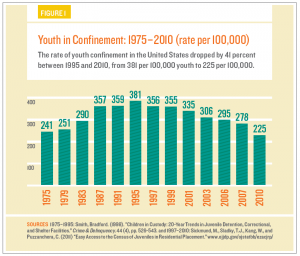The number of children and adolescents (under age 21) who are incarcerated has been steadily dropping since the mid-1990s according to a report by the Annie E. Casey Foundation that presents data from the U.S. Department of Justice Office of Juvenile Justice and Delinquency Prevention. The 2010 national rate of 225 youth per 100,000 is the lowest in 35 years.
The drop has not been associated with an increase in youth crime (which has actually fallen as well). The most recent 2010 data show that, on a given day,  approximately 70,000 youth across the country are detained in juvenile or adult retention facilities or mandated residential placement. About 70% of these placements are for more than 90 days, and the majority of offenses that resulted in the placement were nonviolent. Of note, the report states that, despite the drop, the U.S. still incarcerates a higher percentage of youth than most every other developed nation.
approximately 70,000 youth across the country are detained in juvenile or adult retention facilities or mandated residential placement. About 70% of these placements are for more than 90 days, and the majority of offenses that resulted in the placement were nonviolent. Of note, the report states that, despite the drop, the U.S. still incarcerates a higher percentage of youth than most every other developed nation.
There were marked differences in these rates according to race with Asian youth rates lower than their white peers and African American, Latino, and American Indian rates higher. There was also large variability between states that ranged from a high in South Dakota (575 per 100,000 youth) to Vermont (53 per 100,000 youth). After Vermont, the next lowest state was Hawaii (90 per 100,000 youth).
The reason for the decline is unclear but was not due to a targeted national strategy. Changes in state policy, lawsuits, and cost concerns all likely are playing a role in this decline. These data are not able to determine whether the drop in incarceration rate is also a function of lower levels of youth behavior problems.
The Foundation urges additional efforts to find alternatives to incarceration when appropriate and to provide adequate treatment in these settings.

